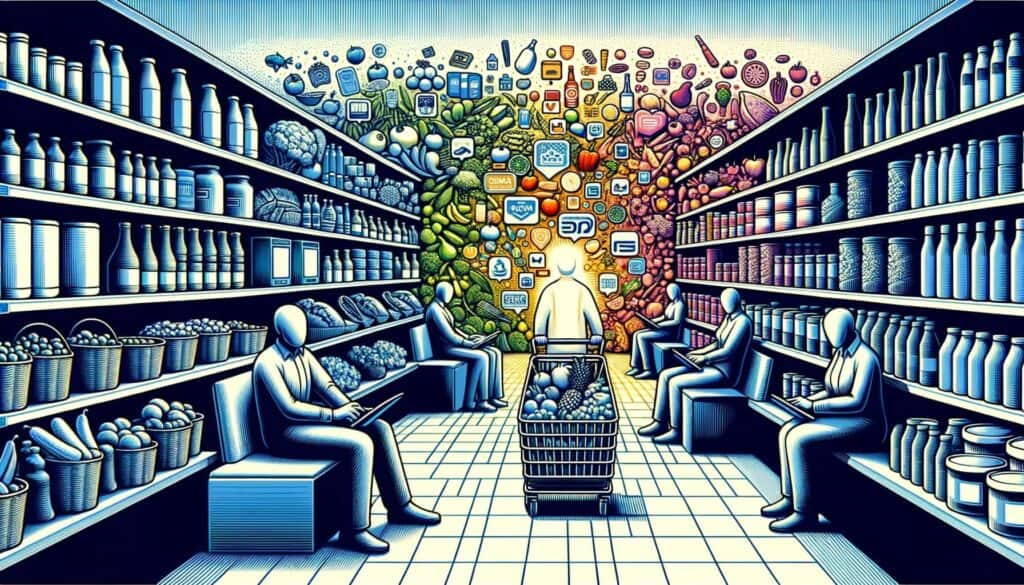
By admin April 16, 2025
The Supplemental Nutrition Assistance Program (SNAP) plays a crucial role in providing food assistance to low-income individuals and families in the United States. As an independent retailer, it is essential to recognize the importance of supporting SNAP customers and ensuring their access to nutritious food options. By implementing various strategies, independent retailers can create an inclusive and supportive environment for SNAP customers, ultimately benefiting both the community and their business.
Creating an Accessible and Welcoming Environment for SNAP Customers

Creating a welcoming and inclusive environment is essential for all customers, including those utilizing SNAP benefits. Here are some strategies to foster inclusivity:
1. Training Staff: Educate your staff about SNAP benefits, eligibility requirements, and the importance of treating SNAP customers with respect and dignity. This training will help them provide better assistance and create a welcoming atmosphere.
2. Store Layout: Organize your store in a way that makes it easy for SNAP customers to navigate and find the products they need. Clearly label sections and aisles, and consider placing essential items near the entrance for convenience.
3. Store Signage: Display signs that indicate your acceptance of SNAP benefits, making it clear to customers that they can use their benefits at your store. This will help SNAP customers feel more comfortable and encourage them to shop at your establishment.
4. Shopping Carts and Baskets: Ensure that your store provides accessible shopping carts and baskets for customers with mobility challenges. This will make their shopping experience more convenient and inclusive.
5. Store Hours: Consider extending your store hours to accommodate the schedules of SNAP customers who may have limited availability due to work or other commitments. This flexibility will enhance their shopping experience and demonstrate your commitment to their needs.
Expanding Product Selection to Cater to SNAP Customers’ Needs

Expanding your product selection to cater to the needs of SNAP customers can enhance their shopping experience and increase their access to nutritious food. Consider the following strategies:
1. Fresh Produce: Increase the availability of fresh fruits and vegetables in your store. Partner with local farmers or suppliers to source affordable, locally grown produce. This will provide SNAP customers with healthier options and support local agriculture.
2. Whole Grains and Legumes: Stock a variety of whole grains, such as brown rice and quinoa, as well as legumes like lentils and beans. These nutritious and affordable options are essential for SNAP customers looking to stretch their food budget while maintaining a balanced diet.
3. Healthy Snacks: Offer a wide range of healthy snacks, such as nuts, seeds, and dried fruits, that are eligible for purchase with SNAP benefits. This will provide customers with nutritious alternatives to processed snacks.
4. Affordable Proteins: Include affordable protein sources like canned tuna, chicken, and beans in your product selection. These options are not only nutritious but also cost-effective for SNAP customers.
5. Special Dietary Needs: Consider expanding your product range to include items that cater to customers with special dietary needs, such as gluten-free, dairy-free, or vegan options. This inclusivity will ensure that all SNAP customers can find suitable products.
Implementing Effective Pricing Strategies for SNAP Customers

To streamline the shopping experience for SNAP customers, it is essential to implement SNAP-friendly payment options and technology. Consider the following strategies:
1. Competitive Pricing: Offer competitive prices on essential items to ensure that SNAP customers can stretch their benefits further. Regularly compare your prices with those of nearby stores to remain competitive.
2. Bulk Purchasing: Provide bulk purchasing options for staple items like rice, pasta, and canned goods. Buying in bulk allows SNAP customers to save money in the long run and stock up on non-perishable items.
3. Sales and Promotions: Offer regular sales and promotions on nutritious items to incentivize SNAP customers to choose healthier options. This can be done through weekly specials, loyalty programs, or discounts on specific products.
4. Price Labeling: Clearly label prices on shelves and products to help SNAP customers make informed purchasing decisions. This transparency will enable them to compare prices and choose the most affordable options.
5. Price Matching: Consider implementing a price matching policy to ensure that SNAP customers receive the best possible prices. This will build trust and loyalty among your customers.
Providing Education and Resources on Healthy Eating Choices

Properly educating your staff on SNAP policies and procedures is crucial to ensure smooth transactions and provide accurate information to SNAP customers. Consider the following strategies:
1. Nutrition Education: Offer workshops or classes on nutrition and healthy eating choices. Collaborate with local nutritionists or dietitians to provide valuable information to SNAP customers, empowering them to make healthier food choices.
2. Recipe Cards: Create recipe cards featuring affordable and nutritious meals that can be prepared using ingredients available in your store. Display these cards near relevant products to inspire SNAP customers and provide them with practical meal ideas.
3. Cooking Demonstrations: Organize cooking demonstrations in your store, showcasing simple and budget-friendly recipes. This interactive approach will engage SNAP customers and help them learn new cooking techniques.
4. Nutritional Labels: Clearly display nutritional labels on products to help SNAP customers make informed decisions about their purchases. Highlight key nutritional information, such as calories, fat content, and sugar content, to promote healthier choices.
5. Online Resources: Develop an online platform or blog where SNAP customers can access educational resources, recipes, and tips for healthy eating on a budget. This digital resource will provide ongoing support and guidance.
Collaborating with Local Organizations to Support SNAP Customers
Collaborating with local organizations and government agencies can strengthen your support for SNAP customers and create a more comprehensive network of assistance. Consider the following strategies:
1. Food Banks and Pantries: Establish partnerships with local food banks and pantries to ensure that SNAP customers have access to additional food resources. Coordinate efforts to distribute surplus food and reduce food waste.
2. Community Gardens: Support community gardens by providing resources or space for SNAP customers to grow their own produce. This initiative promotes self-sufficiency and encourages healthy eating habits.
3. Non-Profit Organizations: Collaborate with non-profit organizations that focus on food security and nutrition. By working together, you can create programs and initiatives that directly benefit SNAP customers in your community.
4. Local Schools: Partner with local schools to promote healthy eating habits among students and their families. Offer discounts or special promotions to families with children enrolled in school meal programs.
5. Volunteer Opportunities: Encourage your staff and customers to volunteer at local organizations that support SNAP customers. This involvement will foster a sense of community and demonstrate your commitment to social responsibility.
Streamlining the SNAP Application Process for Customers
1. Application Assistance: Provide assistance to SNAP customers who may need help with the application process. Train staff members to guide customers through the application and answer any questions they may have.
2. Application Workshops: Organize workshops or information sessions to educate SNAP customers about the application process, eligibility requirements, and necessary documentation. This proactive approach will empower customers to apply confidently.
3. Application Kiosks: Set up dedicated kiosks or computer stations in your store where SNAP customers can complete their applications online. Offer technical support to ensure a smooth application process.
4. Language Accessibility: Ensure that application materials and assistance are available in multiple languages to cater to diverse communities. This inclusivity will eliminate language barriers and make the application process more accessible.
5. Follow-Up Support: Provide ongoing support to SNAP customers after they have submitted their applications. Offer assistance with any follow-up requirements or documentation needed to complete the process successfully.
Enhancing Customer Service and Support for SNAP Customers
1. Sensitivity Training: Train your staff to be sensitive to the needs and challenges faced by SNAP customers. Encourage empathy and understanding to create a supportive environment.
2. Personalized Assistance: Offer personalized assistance to SNAP customers, such as helping them find specific products or suggesting budget-friendly options. This individualized attention will enhance their shopping experience.
3. Customer Feedback: Encourage SNAP customers to provide feedback on their shopping experience. This feedback will help you identify areas for improvement and make necessary adjustments to better serve their needs.
4. Complaint Resolution: Establish a clear process for resolving customer complaints or concerns promptly. Addressing issues effectively will demonstrate your commitment to customer satisfaction.
5. Inclusive Policies: Implement policies that prioritize the needs of SNAP customers, such as allowing flexible payment options or accommodating special requests. These inclusive policies will foster loyalty and trust among your customers.
Utilizing Technology to Improve SNAP Customer Experience
1. Online Ordering: Develop an online ordering system that allows SNAP customers to order groceries for pickup or delivery. Ensure that the system is user-friendly and accessible to all customers.
2. Mobile Apps: Create a mobile app that provides information on product availability, prices, and promotions. This app can also include features like recipe suggestions and personalized shopping lists.
3. Digital Coupons: Offer digital coupons that can be easily accessed and redeemed by SNAP customers. This convenience will help them save money and encourage repeat purchases.
4. Loyalty Programs: Implement a loyalty program that rewards SNAP customers for their continued support. Offer exclusive discounts or benefits to incentivize their loyalty.
5. Social Media Engagement: Utilize social media platforms to engage with SNAP customers, share educational content, and promote special offers. This digital presence will help build a sense of community and foster customer loyalty.
FAQs
Q1. What is the purpose of the SNAP program?
Answer: The SNAP program aims to provide eligible low-income individuals and families with funds to purchase nutritious food, thereby reducing food insecurity and promoting better health outcomes.
Q2. How can independent retailers benefit from supporting SNAP customers?
Answer: Supporting SNAP customers can lead to increased foot traffic, customer loyalty, and positive community reputation, ultimately benefiting the bottom line of independent retailers.
Q3. Can independent retailers choose not to accept SNAP benefits?
Answer: While independent retailers have the option to participate in the SNAP program, accepting SNAP benefits can provide numerous advantages, including access to a broader customer base and increased revenue potential.
Conclusion
Supporting SNAP customers is not only a social responsibility but also a smart business strategy for independent retailers. By creating an accessible environment, expanding product selection, implementing effective pricing strategies, providing education and resources, collaborating with local organizations, streamlining the application process, enhancing customer service, and utilizing technology, independent retailers can ensure that SNAP customers have access to nutritious food options and a positive shopping experience.
By prioritizing the needs of SNAP customers, independent retailers can contribute to the well-being of their community while building a loyal customer base.